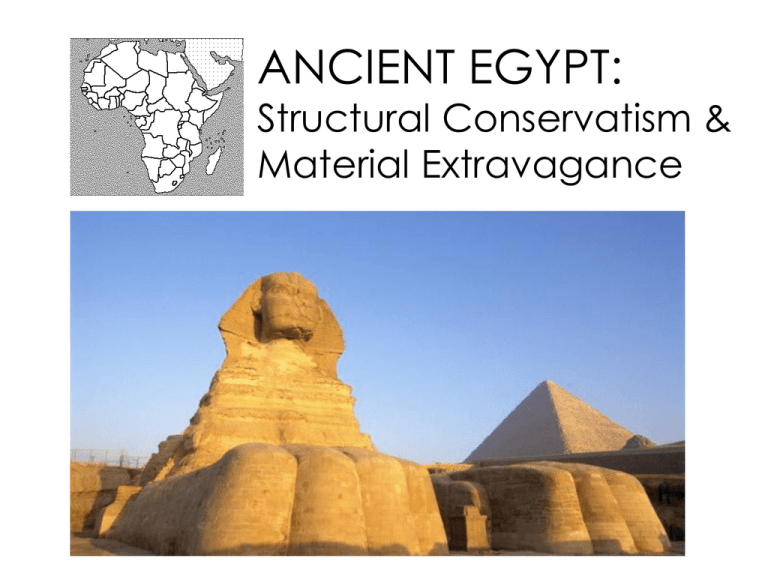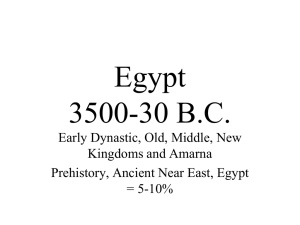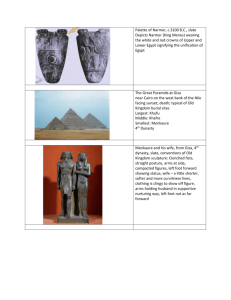Egypt - Faculty
advertisement

ANCIENT EGYPT: Structural Conservatism & Material Extravagance The Nile River Valley • due to basic human needs for sustenance it is no surprise the Nile River Valley developed as it did: – – – – – water fertilization transportation building materials aesthetic inspiration mastaba Old Kingdom (2680–2181 B.C.) •sepulchral structure built above ground •elaboration of pre-dynastic burial-pit & mound form •generally rectangular in plan with a flat roof and inwardsloping walls • built of brick and faced with limestone slabs • angle of repose—natural “structure” of earth when piled • battered—or has a slope Pyramids of Giza Structural Conservatism • Skiomorphosis - describes that process whereby a form is invented in one material as a response to the physical properties of that material and then transferred to another material whose properties do not demand that form. Segregation of Classes • Division of class – – – – Royalty Military Laboring class Merchant class • Segregation of residential districts Temple Complex at Karnac Trabeated Construction Lintel: Horizontal Element Post: Vertical Element Battered Wall Cavetto Cornice Temple of Edfu: The Main Pylon/Gate Obelisk Temple of Amon at Karnac Path or Axis Temple of Amon at Karnac Axial Planning Additive Construction Hypostyle Hall: Nature’s Grid SUN NILE Hypostyle Hall Lotus Flower Capital Clerestory Latin: hypo-inside, style-column hierarchy of society (statues and restricted spaces) fused in architecture The Dense Forest Applied Polychromy HIEROGLYPHICS Bas (Low) Relief Carving Incised Carving Arab World Institute Notre Dame Jean Nouvel, Paris France, 1983-87 Light Sensitive Windows Jean Nouvel’s Hypostyle Hall Interior of Nouvel’s Hypostyle Interior of Arab World Institute INTERIORS • Egyptian Pyramids – Eternal • Egyptian Villas and Palaces – Absence of ceremony and its effect on the interior – Symbolic journey of life – Importance of the hearth – Movable furniture – Ephemeral Model of a Villa of an aristocratic family at Te El Armana, 18th Dynasty, New Kingdom (reconstructed from archeological evidence) Walls were a canvas for carving or painted murals. Wooden shutters or grilles for windows. Plan of a Villa of an aristocratic family at Te El Armana, 18th Dynasty, New Kingdom (reconstructed from archeological evidence) Sun-baked earthen floors cooler than having textiles. Egyptian Furniture Products of the Vernacular • Products for ordinary people • Local materials • Priority of function Products of the High Style • Products for the elite • Extravagant materials • Followed them to the afterlife Alabaster Lamp Diagonal Struts Wrapped Joints table and oil lamps, Old Kingdom Wood Joinery Bedroom Suite of Queen Hetepheres, c. 2300 BCE Wood encased in gold; loose cushions covered in cotton, painted leather, metallic cloth Folding Bed, Middle Kingdom Headrest from the tomb of Tutankhamun, c. 1352 Often wrapped in linen Lotus Blossom Reeds Zoomorphic furniture Impost Block The Discovery of King Tut’s Tomb by Howard Carter (1922) The Antechamber (Evidence of trade; Greek artifacts found in tombs) http://www.geocities.com/Athens/Delphi/3499/MUMMY.HTM Burial Chamber Entrance An Unbroken Seal The Primary Sarcophagus of King Tutankhamen http://www.thebanmappingproject.com/ Stool from the tomb of Tutankhamun, c. 1352 BCE • Seating – Stool Painted and Guilded Stool, 18th dynasty • Seating – Stool – Chair • Seating – Stool – Chair – Arm chair Arm Chair from the tomb of Tutankhamun, c. 1352 BCE • Seating – – – – Stool Chair Arm chair Throne Use of textiles on furnishings: 1. Loose cushion 2. Pads or rolls of fabric secured over the back and seat of chair 3. Leather (cowhide or goat skin) as collapsible sling Shrine Shaped Box, Old Kingdom Chest on Legs, Old Kingdom Egyptian Decorative Arts Ivory hunting dog Late Dynasty 18, 1400-1350 B.C. Ivory, tinted red inside mouth and black around eyes and on undersides of paws, l. 7 1/8 in. Hippopotamus Thebes, area of Deir el-Bahri, Dynasty 18, ca. 1450 B.C. Painting on limestone, 4 11/16 x 4 1/8 in. Cat Ptolemaic Period, 305-30 B.C. Bronze, h. 11 in. Prancing Horse, New Kingdom, late Dynasty 18, probably reign of Amenhotep III, ca. 1391–1353 B.C. Egyptian Ivory, garnet inlay; L. 6 in. (15 cm) Make-up Palettes in the form of Turtles, Old Kingdom Pectoral of Princess Sithathoryunet Lahun Dynasty 12, reign of Senwosret II, ca. 1897-1797 BCE Gold, carnelian, feldspar, garnet, and turquoise; l. 3 1/4 in. Egyptian Revivals • The first occurs in the early 19th century due to Napoleon’s campaigns in Egypt and the resulting Descriptions of Egypt. • The second is concurrent with Carter’s discovery of King Tut’s Tomb in the early part of the 20th century. Clock, 1808, Benjamin Vulliamy Black Marble and Ormolu Grauman’s Egyptian Theater Egyptian Theater Boise, Idaho





